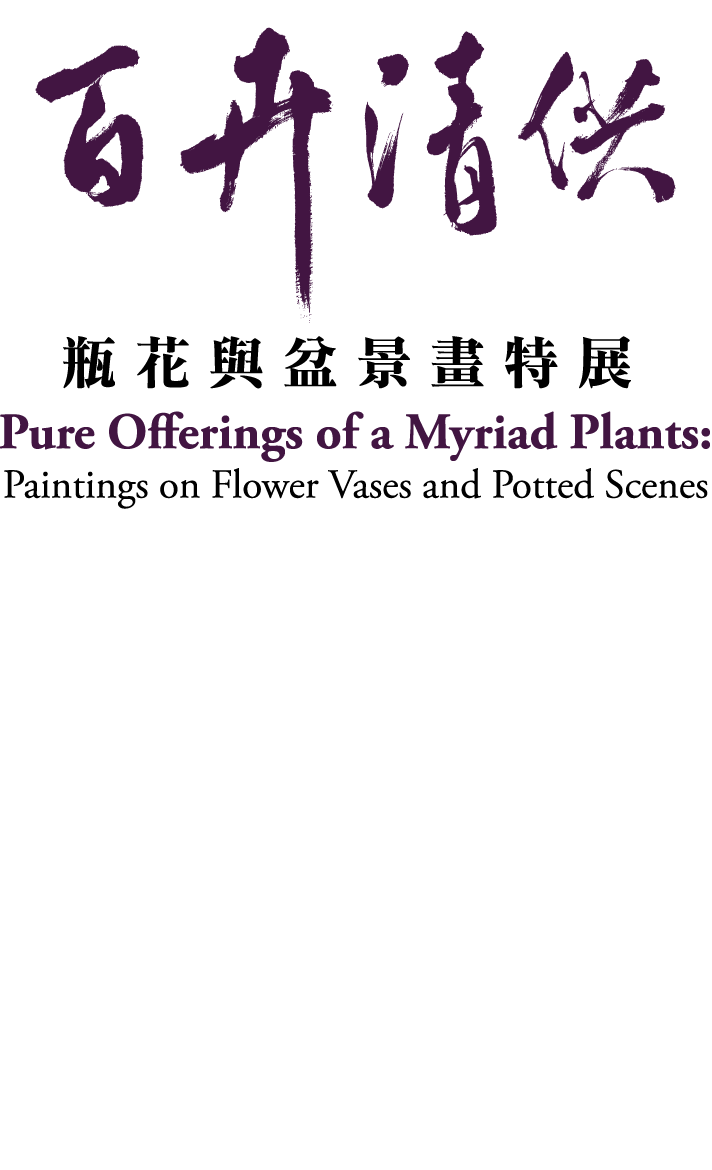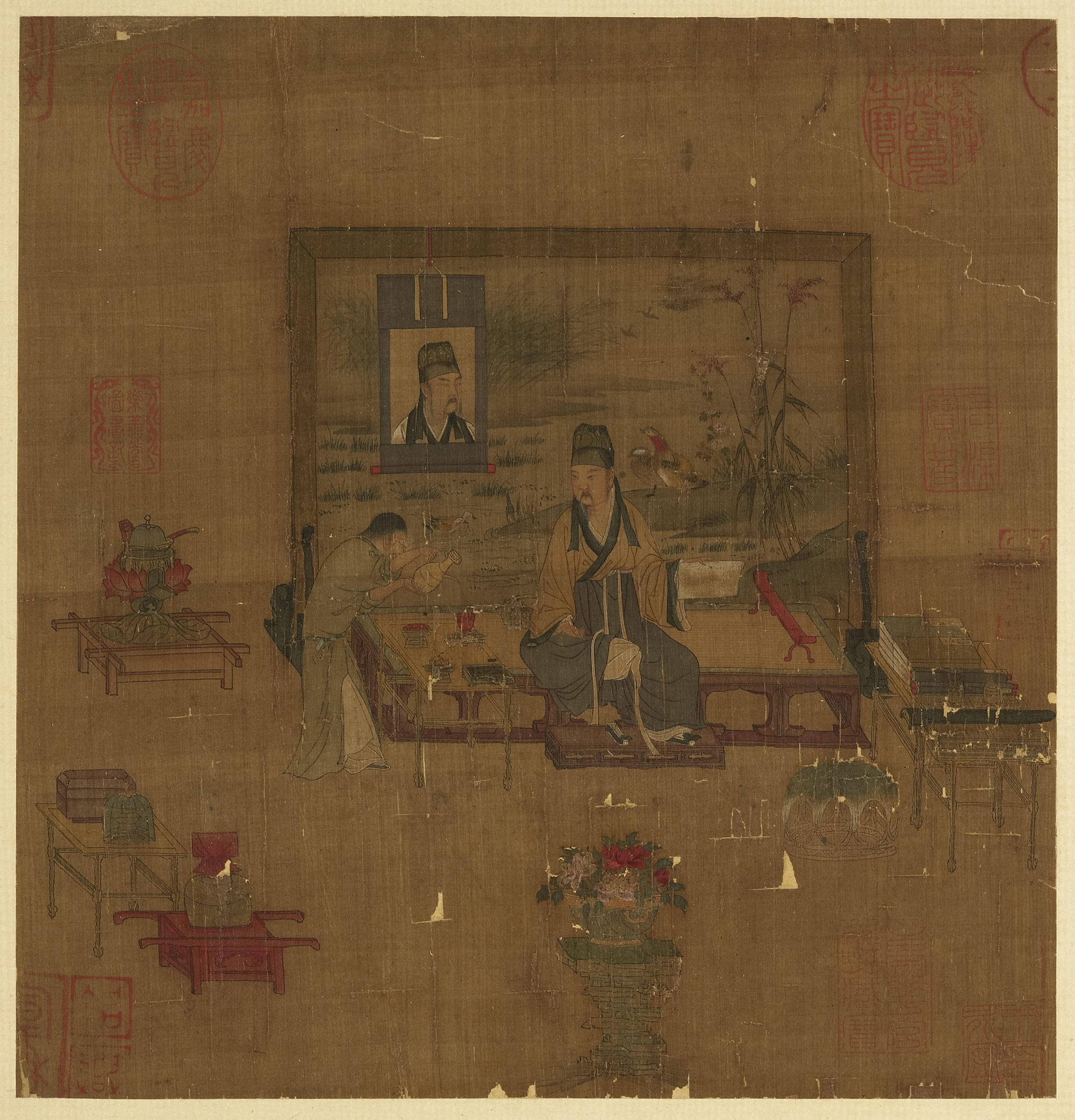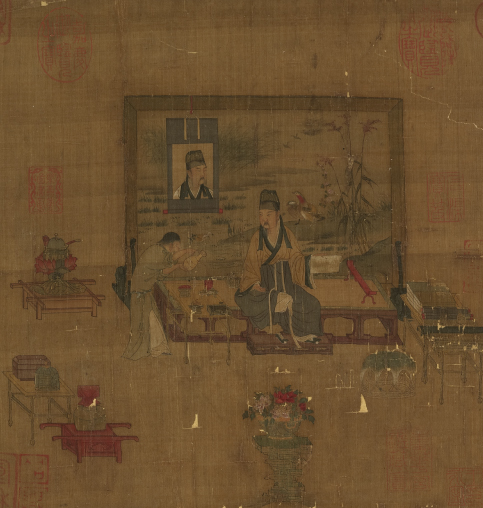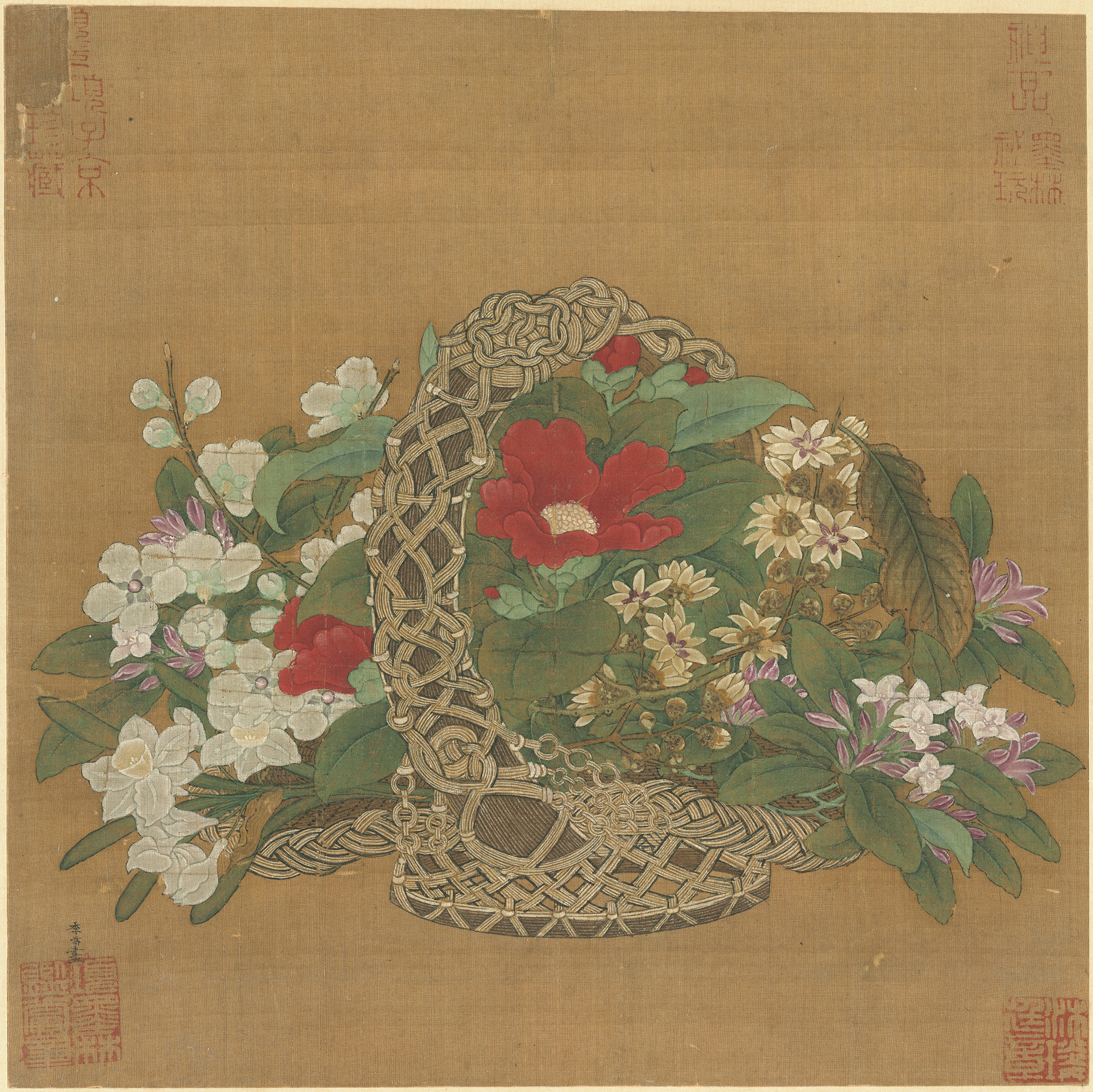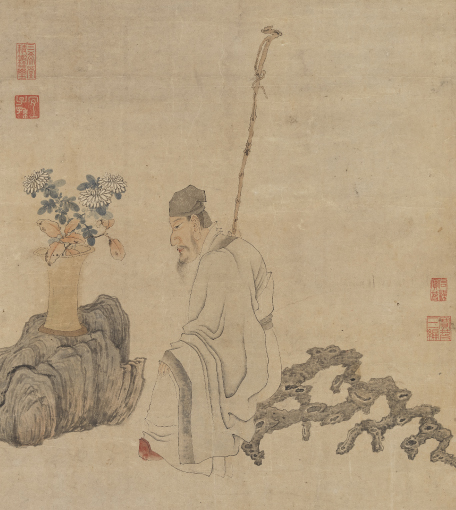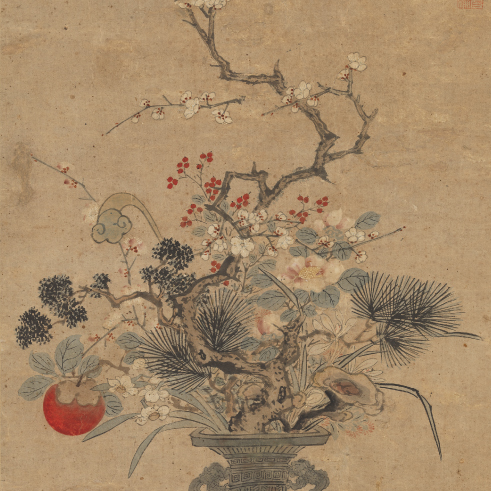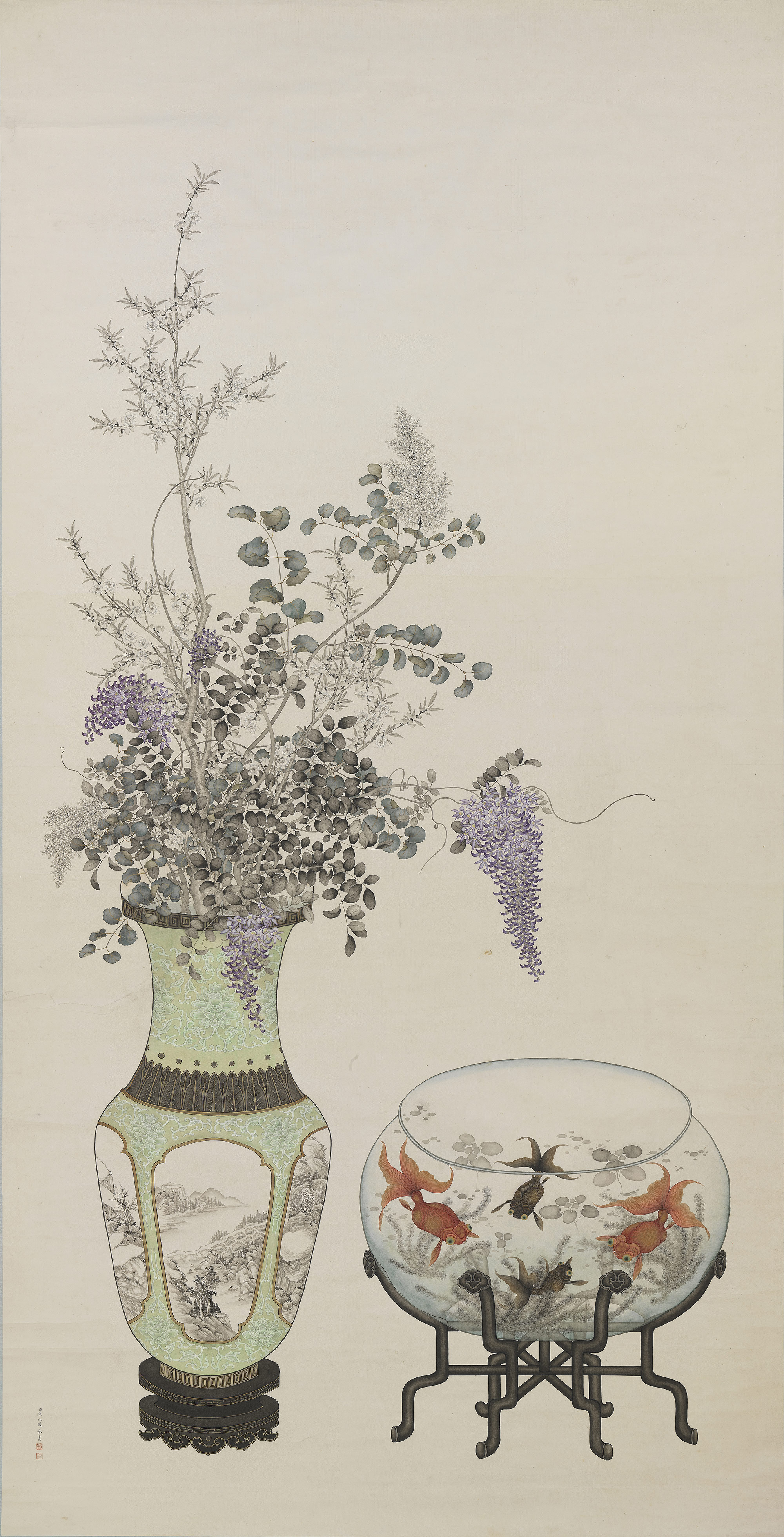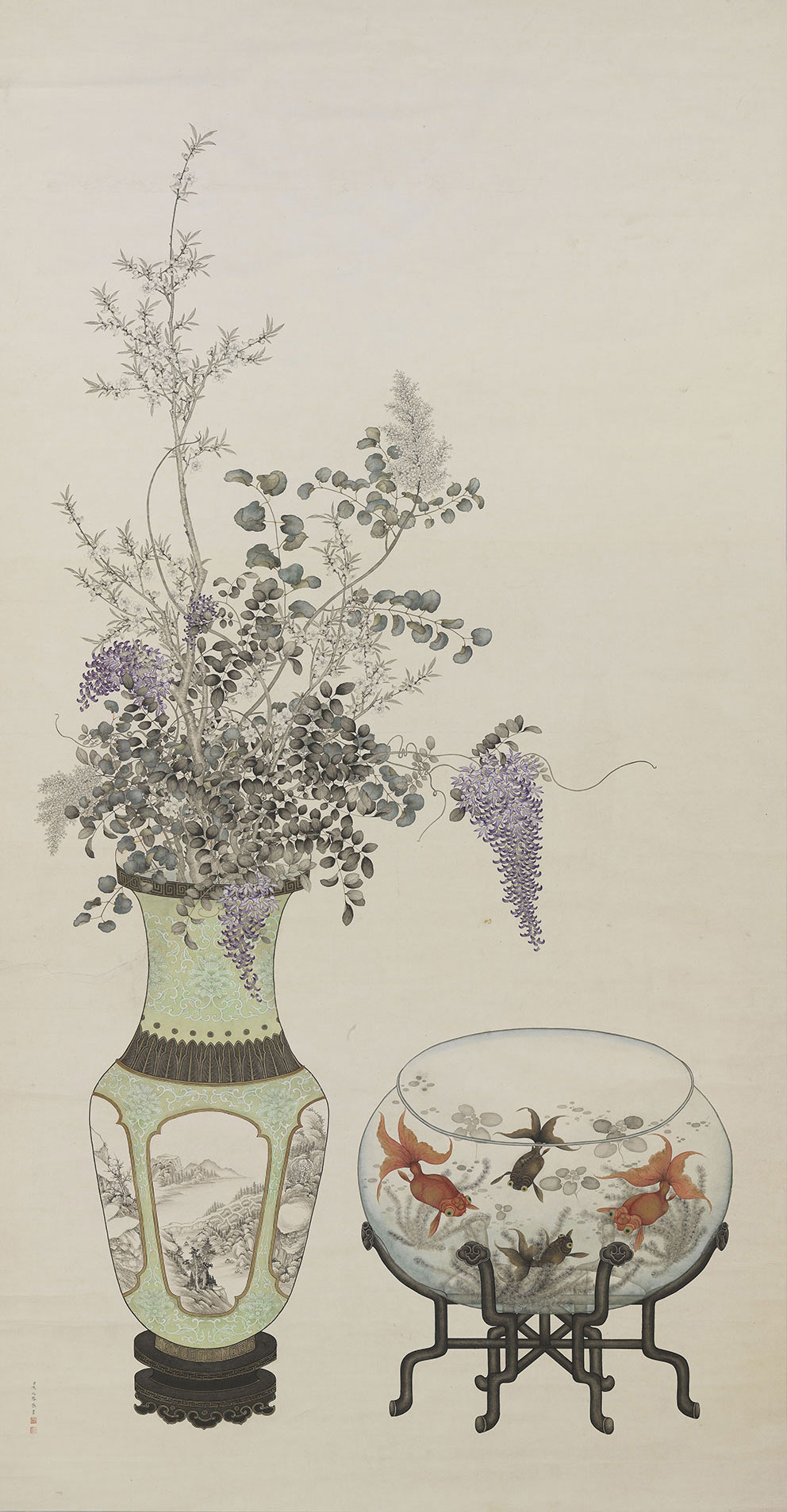Flowers in Vases
-
The art of arranging cut flowers and plants in vessels has religious origins in China with floral offerings to Buddhist deities. Mostly as lotus blossoms in vases, this flower bears special implied meaning of "neither spreading nor branching, unstained and remaining pure." In the Tang dynasty and Five Dynasties period, the elegant pastime of enjoying flowers in gardens spread from the court to the people, the custom of being surrounded by floral arrangements becoming popular. By the Song dynasty, it was also common to place seasonal flowers in the halls or studios of households, representing one of the four elegant pursuits of the literati: arranging flowers, burning incense, drinking tea, and hanging paintings.
-

-
From the Yuan and Ming dynasties onward, flower vase arrangements also became an important subject in painting. Particular attention was paid to sumptuous and extravagant floral arrangements in halls, while flowers in vases were part of the pure aesthetic of the scholar's studio. Among the people, the focus was on pure offerings of seasonal flowers and plants with auspicious meaning. The art of vase flowers emphasized form and linear proportion, the choice of vessels varied in terms of material, type, and style. The trend towards "antiquities and pure offerings" then evolved into a unique theme by the Qing dynasty, the flowers combined with antiques, fruits and vegetables, spirit fungus, and ornaments. The homophones of these put together have auspicious significance that continues nowadays to serve as blessings for peace and prosperity as well as wishes for a good life.
-
Scholar
- Anonymous, Song dynasty (960-1279)
- Album leaf, ink and colors on silk, 29 x 27.8 cm
A scholar sits at the edge of a daybed with one foot on a footrest and the other raised by his thigh as he recites poetry and admires flowers. Placed around him are a table, stool, zither and go set, scrolls, tea stove, potted flowers, and food and drink. Hung on the screen behind is a small scroll, the figure in the portrait similar to the main character here. The arts of the zither and go, painting and calligraphy, flower arrangement, and drinking tea represented elegant pastimes of the scholar's studio, making this an ideal representation of the literati pursuit of archaic refinement.
The potted flowers are placed on a platform of piled flat rocks. With a few branches of peonies, the blossoms float on the surface of the water, the colors gorgeous. The wide flaring water basin has a floral ridge meticulously rendered, the vessel rim inlaid with gold and featuring a handle on each side. Branches are faintly seen on the body of the vessel, suggesting it is made of glass. At the top of this work, the first leaf from the album "Collected Works of Painting Through the Ages," are the collection seals of the twelfth-century emperors Huizong and Gaozong from the Northern and Southern Song periods, respectively.
-
Flower Basket
- Li Song (fl. ca. 1190-1264), Song dynasty
- Album leaf, ink and colors on silk, 26.1 x 26.3 cm
Li Song, a native of Qiantang in Zhejiang, once worked as a carpenter as a youth but was later adopted by Li Congshun (fl. 1120-1160), a Painter-in-Attendance at the Painting Academy in the Xuanhe reign of the late Northern Song. Li Song excelled at figure, landscape "ruled-line," and flower painting.
The basket shown here is full of flowers in early spring, making for a festive and auspicious atmosphere for the start of the New Year. The red camellia, green-sepaled plum blossoms, narcissi, chimonanthus, and daphne are placed closely together in a colorful and fragrant combination with a full and flourishing effect. The large camellia blossoms stand out from the others, which extend on either side to highlight them, the density of the arrangement balanced. The crescent-shaped braided basket is meticulously detailed, the coloring rich yet elegant, making this work, the sixth leaf from the album "Collected Paintings of the Ages," a masterpiece of Song dynasty flower-basket arrangement.
-
Appreciating Chrysanthemums
- Chen Hongshou (1598-1652), Ming dynasty
- Hanging scroll, ink and colors on paper, 118.6 x 55.1 cm
A lofty scholar is seated holding a staff in leisurely ease. His seat is a gnarled tree trunk carved into an unusual openwork form. A vase of chrysanthemums is placed on a rock before him. The picked chrysanthemums and withered yellow persimmon leaves are arranged in the vase with their hues plain and elegant for a pure offering of appreciation.
The famous recluse-poet Tao Yuanming (365-427) gave up office and returned to his hometown to lead a life of leisure with no regard for fame or fortune. Literati over the ages often alluded to stories of him drinking wine and picking chrysanthemums, which symbolize the recluse and the lofty integrity of a gentleman. The figure in this painting not only admired the flowers but also represents a realm in which object and viewer are transformed into one, reflecting a form of yearning and closeness with nature. The chrysanthemum was a favorite object of depiction by Chen Hongshou in his later years, this work being a gift to a friend in his memory.
-
Painting for the New Year
- Attributed to Bian Wenjin (ca. 1356-1428), Ming dynasty
- Hanging scroll, ink and colors on paper, 108 x 46.1 cm
In this offering of flowers for the first day of the Lunar New Year, a vessel is shown with a flaring mouth and a long neck, representing an imitation bronze rectangular "gu." There are flanges on the body and "thunder," plantain-leaf, and cloud decoration. The floral arrangement includes plum blossoms, orchids, camellia, narcissi, nandina, spirit fungi, pine and cedar branches, persimmon, and ruyi for a total of ten that symbolize the Chinese expression for "ten perfections, ten beauties," which beckons auspiciousness and prayers for fortune. The structure overall is rigorously presented, the flowers and branches below creating a full arcing shape as a plum branch reaches to lofty heights. The juxtaposition of solid and void above and below is balanced, and the variations to the bending branches add a sense of harmony to the painting surface.。
This work is dated to "The first day of spring in the second year of the Xuande reign (1427), produced by Bian Wenjin of Longxi." The brushwork, however, differs from other works associated with this Ming dynasty court painter, suggesting the signature had been added by a later hand.
-
Vase of Flowers and a Goldfish Bowl
- Chen Zhaofeng, Qing dynasty (1644-1911)
- Hanging scroll, ink and colors on paper, 231.7 x 117.7 cm
Chen Zhaofeng (style name Mengqi) was active during the Tongzhi (1861-1875) and Guangxu (1875-1908) reigns in the late Qing dynasty. Skilled at bird-and-flower subjects, he was a painter at the Ruyi Hall and rose to the Seventh Rank with Finial in 1881, serving the inner court for more than twenty years until his retirement in old age.
This large hanging scroll features a tall porcelain vase with an arrangement of wisteria and peach blossoms for a combination of green leafy branches and purple flowers. The length and angle of each floral branch had to be planned beforehand and then a way found to fix them into position within the vase. The exterior of the vase is decorated with a lotus-blossom pattern and plantain-leaf decoration around the shoulder. The panels on the body include painted landscapes, their production quite fastidious. Inside the glass basin to the side are goldfish swimming among water plants at leisure. The wisteria, vase, and goldfish symbolize the idea of "auspicious peace in halls overflowing with wealth." These would have been auspicious items to place at the court and serve as pure offerings.
